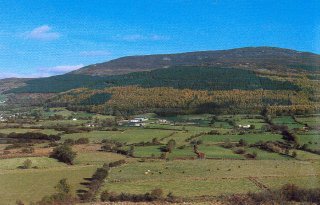At the suppression of the Killeavey Convent under Henry VIII in the 1540s – a Convent then believed to be under the authority of the Culdees – the lands were seized and allotted to one Marmaduke Whitchurch. He failed to prosper there but a daughter married Nicholas Seaver of Lusk,
So began centuries of Seavers domination in Slieve Gullion. Today besides the road of that name, the only memory of the Seavers is on the tombstones of the
Nicholas Seaver died in 1687 and he was succeeded by a son Charles who married his cousin Mary Powell. It was 1722 before he was succeeded by his son Jonathan who became hereditary Sheriff of Armagh in 1748. Two years later he expired and was succeeded by Thomas Seaver who built the residence that became known as Heath Hall.
When Thomas died in 1788 he was succeeded by the infamous Jonathan, known as ‘Seaver of the Bog’. It was he who founded the never-to-be-forgotten Killeavey Yeomanry, recruited from Eshwarry and Divernagh, and who, with the even-more-infamous ‘Ancient Britons’ ravaged and pillaged Irish and Catholic homesteads the length and breadth of South Armagh – and even into South Down, as elsewhere here reported. Seaver of the Bog was born in 1760 and died in 1841. He is buried at Meigh.
His first-born son Thomas came to acquire a peculiar pedigree. In 1824, at the age of thirty seven, and already a rabid Orangeman, Captain of his father’s Yeomanry and indeed also Captain of the Monaghan Yeomanry, he married a local girl Jane McNeill of Faughart. They emigrated and settled in Post-Revolutionary France and indeed lived there for the following seventeen years. When he returned to
Thomas’s politics had altered radically during his exile in
Thomas however, within a few short years became a victim of that disease consequent upon the Great Hunger that was soon to afflict so many of the people of
His son Thomas found on succession that Heath Hall and its estate was mortgaged to the then incredible sum of
